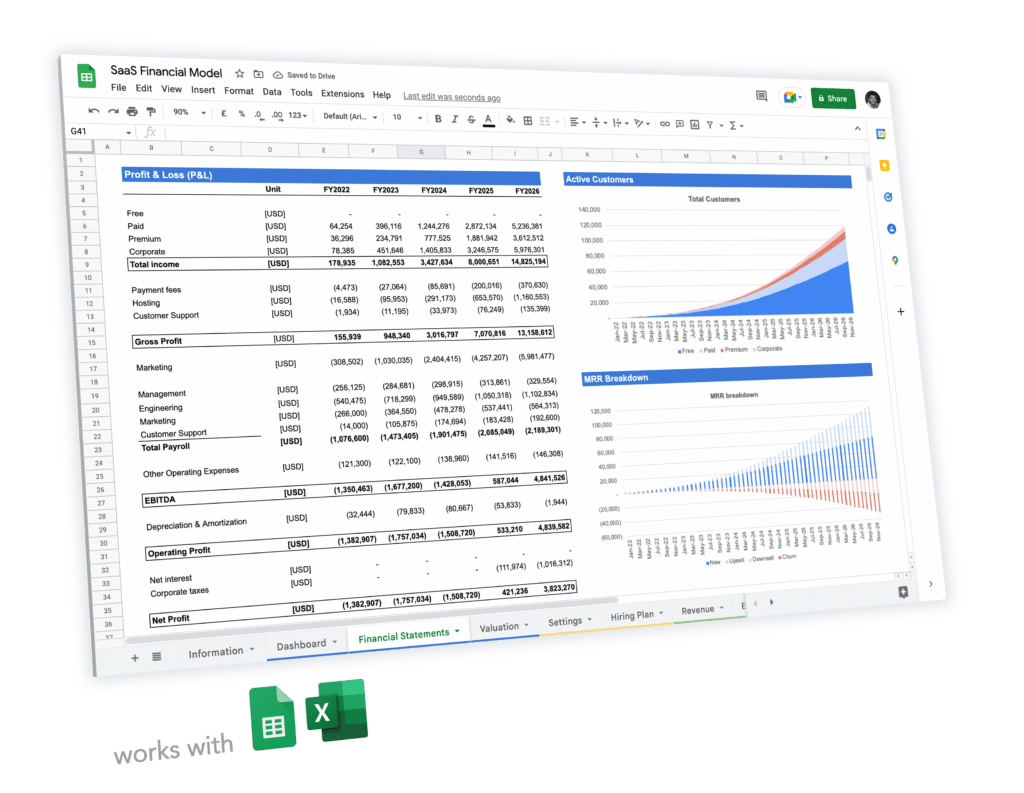How To Use Industry Benchmarks For Your Startup Financial Plan

You might have heard of industry benchmarks when preparing your business plan, your financial plan or your pitch deck. Investors might have asked you how your budget compares to industry benchmarks. But why?
Industry benchmarks are industry average financial and operational metrics which help build more accurate forecast and compare a business’ actual performance vs. competition. When budgeting, you could say benchmarks make sure we are not shooting in the dark and our numbers are believable, realistic and accurate.
That’s why investors care a great deal about industry benchmark. Therefore you should care about it too.
In this article we will explain you how you can use industry benchmarks to create rock-solid financial projections for your startup. Let’s dive in!
What are industry benchmarks?
Industry benchmarks are metrics from existing companies that have been averaged per industry (e.g. retail, SaaS, ecommerce, etc.) to serve as a guidance for investors and companies themselves.
There are many metrics, financial and operational, that have been compiled and averaged across various industries. Whether you are looking for average software engineers salaries in tech in Europe or the average gross margin of ecommerce companies, there are benchmarks out there you can use to make better decisions.
A few examples of industry benchmark metrics you can use for your startup include:
- Financial metrics: Gross margin, Net profit margin, Customer Acquisition Cost, etc.
- Operational metrics: churn rate, conversion rates, returns and cancellations (ecommerce), etc.
Why are we using industry benchmarks?
Industry benchmarks are used by many companies and people worldwide, from CFOs to entrepreneurs to venture capital firms and investors alike. Benchmarks are used for 2 main reasons:
Benchmarks help make better financial forecasts
Forecasting is often not fully accurate, especially for startups. This is even more true when you are building financial projections 3 to 5 years from now.
Even existing businesses that may prepare accurate budgets for the next 12 months based on their historical performance, forecasting beyond that period inherently presents a higher margin of error.
Startups in comparison have limited or no historical performance. In addition, they are typically growing very fast which makes it incredibly hard to accurately forecast the future.
That’s why both existing businesses and early stage startups use industry benchmarks to help them prepare their budgets and financial forecasts. Benchmarks are used as a guidance whenever there is a degree of uncertainty.
For instance, you might be launching your ecommerce business but aren’t sure what conversion rate you can expect. Or you have an existing SaaS business yet you aren’t sure how much you should be spending in customer acquisition costs. In both cases, there is plenty of public information out there that can help you make better forecasts, and ultimately better decisions.
For more information on how to build realistic forecasts for your startup, read our article here.
Benchmarks help understand how you compare vs. competition
All businesses are at some point comparing their performance to their competitors. This analysis help understand whether a business is under or over performing.
Not only businesses do it – investors care a lot about benchmarks.
When investors look at your business plan or pitch deck, they are likely comparing your historical performance and financial projections against industry benchmarks. This help them understand 2 things:
- Whether you are over or under performing. If your track record shows 150% year-on-year revenue growth while competitors only grow by 50% in the same period, investors will give a lot of credit to your execution
- Whether your financial projections are realistic. If you expect no customer churn yet benchmarks show 20% annual churn for your industry, you’re likely too optimistic. Unrealistic projections can be very dangerous: investors may think you haven’t thought out well your business and strategy. Instead, realistic projections will increase your chances of raising capital as investors will give more credit to your forecasts.
Want to know how a solid financial model can dramatically increase your chances to raise capital from investors? Read our article below:
Why are industry benchmarks imperfect?
Benchmarks are very useful and in some cases essential for businesses. Yet, they aren’t necessarily always good to use. Let’s see why benchmarks are sometimes imperfect and when you shouldn’t use them.
Industry benchmarks are a compilation of a number of companies’ metrics averaged in a specific industry. Yet, there are times when they aren’t necessarily helpful. A few reasons are:
- The industry might not be comparable to yours. For example, comparing churn for an Enterprise SaaS software business to a mobile app business doesn’t make any sense. When you are using industry benchmarks, make sure the industry is truly relevant for your business
- The companies might not be comparable to each other. Not all benchmarks are good to use. For instance, ecommerce benchmarks might compare dropshipping to inventory ecommerce businesses. This can make sense for some metrics (e.g. conversion rates) yet do not work at all for others (e.g. net profit margin)
- The metrics aren’t really comparable. Information is often scarce, especially when companies aren’t publicly listed. As such, metrics used for benchmarks are sometimes not truly comparable to each other. Think revenue growth for example: some benchmarks might use as a proxy user growth for some companies when revenue growth isn’t available. Yet, user growth doesn’t necessarily compare to revenue.
How to use industry benchmarks to make better forecasts
Are you preparing a budget for your startup, and you are wondering how to use benchmarks to build rock-solid financial projections? Follow these steps to make good use of industry benchmarks for your startup:
1. Define the metric(s) you are looking for
Do you need help figuring out revenue growth or EBITDA margin for your business? First, make a list of all the metrics, financial or operational you are looking for. Understanding and defining clearly what is it you are after will ensure you are using relevant benchmarks for your forecasts.
2. Nail down your industry
Once you have prepared the exact metrics you are looking for in a benchmark, now is time to clearly identify what industry you are in. Businesses present very different financials across industries and, as such, benchmarks can easily be misleading when you aren’t using the correct one.
If your business is selling products both online and retail (in a shop), looking at net profit margins for online shops only will not be accurate: online shops typically have higher margins vs. retail shops as the latter have rent expenses online stores do not have.
3. Look for benchmarks online
Benchmarks can often be found online. They can be compiled by government bodies or found on companies’ websites (e.g. advisory firms, venture capital, etc.). Make sure you look at specialised blogs and press as well.
Online sources are especially useful as you can always refer to them in your excel financial model of powerpoint investor presentation for others to see. Whenever possible, include a link to the relevant research report or blog article. People will give a lot of credit to your estimates if they also have access to the same information you do.
4. Beware of outliers
Before you use the metrics themselves you just found, make sure they are relevant by sense checking the numbers. You can compare the metrics to your own estimates (when you have some) or your financial performance (if any).
Outliers in the benchmark can skew significantly the metrics. The problem is that often, each of the companies’ data used in the benchmark aren’t available. This is simply due to the fact that companies’ information is private, and therefore confidential. Anonymised averages in comparison can be used for public purposes instead.
For example, if you are comparing your early stage startup to a benchmark including some publicly listed companies, be careful: likely due to scale the metrics will be very different.
In general, whether or not you should use a benchmark depends on the availability of information and the degree of comparability to your business. If one or the other is compromised, either disregard the benchmark, or apply a margin of error instead.
5. Use industry averages to build your projections
If you feel you have found a relevant industry benchmark for your business, go ahead and use it as a proxy for your financial forecasts.
For instance, use the 2.0% conversion rate you have found online to calculate the number of orders you can reasonably expect for your ecommerce business.


 5-year pro forma financial model
5-year pro forma financial model 20+ charts and business valuation
20+ charts and business valuation  Free support
Free support